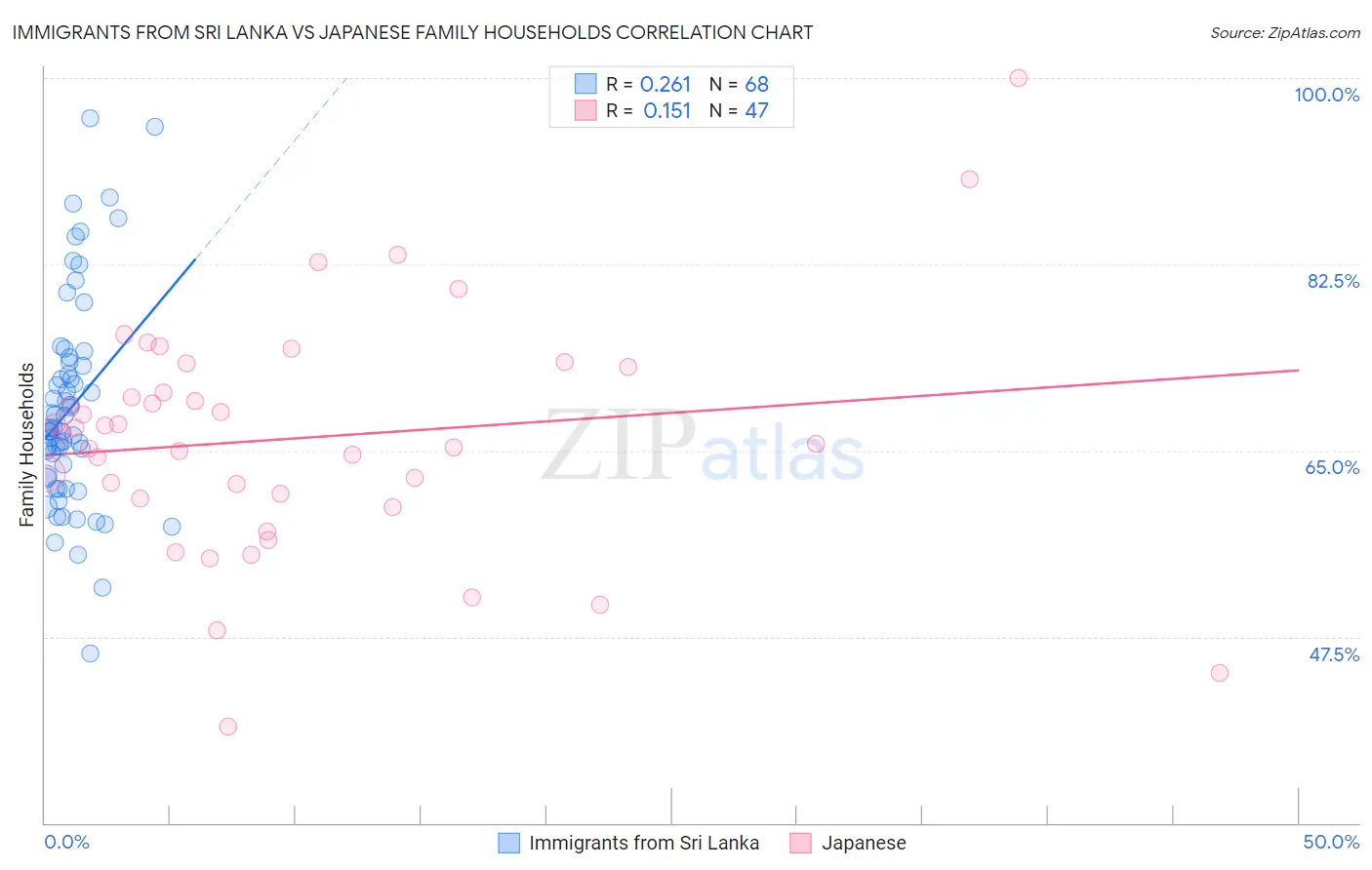Immigrants from Sri Lanka vs Japanese Family Households
COMPARE
Immigrants from Sri Lanka
Japanese
Family Households
Family Households Comparison
Immigrants from Sri Lanka
Japanese
65.1%
FAMILY HOUSEHOLDS
98.0/ 100
METRIC RATING
102nd/ 347
METRIC RANK
65.9%
FAMILY HOUSEHOLDS
99.9/ 100
METRIC RATING
68th/ 347
METRIC RANK
Immigrants from Sri Lanka vs Japanese Family Households Correlation Chart
The statistical analysis conducted on geographies consisting of 149,689,020 people shows a weak positive correlation between the proportion of Immigrants from Sri Lanka and percentage of family households in the United States with a correlation coefficient (R) of 0.261 and weighted average of 65.1%. Similarly, the statistical analysis conducted on geographies consisting of 249,074,128 people shows a poor positive correlation between the proportion of Japanese and percentage of family households in the United States with a correlation coefficient (R) of 0.151 and weighted average of 65.9%, a difference of 1.2%.

Family Households Correlation Summary
| Measurement | Immigrants from Sri Lanka | Japanese |
| Minimum | 45.9% | 39.1% |
| Maximum | 96.3% | 100.0% |
| Range | 50.3% | 60.9% |
| Mean | 69.0% | 66.2% |
| Median | 67.0% | 66.6% |
| Interquartile 25% (IQ1) | 62.5% | 60.5% |
| Interquartile 75% (IQ3) | 73.1% | 72.9% |
| Interquartile Range (IQR) | 10.6% | 12.4% |
| Standard Deviation (Sample) | 9.9% | 11.2% |
| Standard Deviation (Population) | 9.8% | 11.1% |
Similar Demographics by Family Households
Demographics Similar to Immigrants from Sri Lanka by Family Households
In terms of family households, the demographic groups most similar to Immigrants from Sri Lanka are Haitian (65.2%, a difference of 0.020%), Chilean (65.2%, a difference of 0.020%), Indian (Asian) (65.1%, a difference of 0.020%), Spaniard (65.1%, a difference of 0.020%), and Central American Indian (65.2%, a difference of 0.060%).
| Demographics | Rating | Rank | Family Households |
| Immigrants | Portugal | 98.6 /100 | #95 | Exceptional 65.2% |
| Swiss | 98.6 /100 | #96 | Exceptional 65.2% |
| Guatemalans | 98.6 /100 | #97 | Exceptional 65.2% |
| Immigrants | Syria | 98.4 /100 | #98 | Exceptional 65.2% |
| Central American Indians | 98.3 /100 | #99 | Exceptional 65.2% |
| Haitians | 98.1 /100 | #100 | Exceptional 65.2% |
| Chileans | 98.1 /100 | #101 | Exceptional 65.2% |
| Immigrants | Sri Lanka | 98.0 /100 | #102 | Exceptional 65.1% |
| Indians (Asian) | 97.9 /100 | #103 | Exceptional 65.1% |
| Spaniards | 97.8 /100 | #104 | Exceptional 65.1% |
| English | 97.4 /100 | #105 | Exceptional 65.1% |
| Whites/Caucasians | 97.3 /100 | #106 | Exceptional 65.1% |
| Alaska Natives | 97.3 /100 | #107 | Exceptional 65.1% |
| Palestinians | 97.2 /100 | #108 | Exceptional 65.1% |
| Immigrants | Guatemala | 96.9 /100 | #109 | Exceptional 65.0% |
Demographics Similar to Japanese by Family Households
In terms of family households, the demographic groups most similar to Japanese are Fijian (65.9%, a difference of 0.020%), Filipino (65.9%, a difference of 0.020%), Malaysian (65.9%, a difference of 0.030%), Immigrants from Afghanistan (65.9%, a difference of 0.040%), and Costa Rican (65.9%, a difference of 0.060%).
| Demographics | Rating | Rank | Family Households |
| Danes | 100.0 /100 | #61 | Exceptional 66.0% |
| Central Americans | 100.0 /100 | #62 | Exceptional 66.0% |
| Immigrants | Indonesia | 100.0 /100 | #63 | Exceptional 66.0% |
| Pima | 99.9 /100 | #64 | Exceptional 65.9% |
| Costa Ricans | 99.9 /100 | #65 | Exceptional 65.9% |
| Fijians | 99.9 /100 | #66 | Exceptional 65.9% |
| Filipinos | 99.9 /100 | #67 | Exceptional 65.9% |
| Japanese | 99.9 /100 | #68 | Exceptional 65.9% |
| Malaysians | 99.9 /100 | #69 | Exceptional 65.9% |
| Immigrants | Afghanistan | 99.9 /100 | #70 | Exceptional 65.9% |
| Bhutanese | 99.9 /100 | #71 | Exceptional 65.9% |
| Portuguese | 99.9 /100 | #72 | Exceptional 65.8% |
| Laotians | 99.9 /100 | #73 | Exceptional 65.8% |
| Burmese | 99.9 /100 | #74 | Exceptional 65.7% |
| Houma | 99.9 /100 | #75 | Exceptional 65.7% |